brake fluid PONTIAC BONNEVILLE 1995 Owners Manual
[x] Cancel search | Manufacturer: PONTIAC, Model Year: 1995, Model line: BONNEVILLE, Model: PONTIAC BONNEVILLE 1995Pages: 338, PDF Size: 16.19 MB
Page 115 of 338
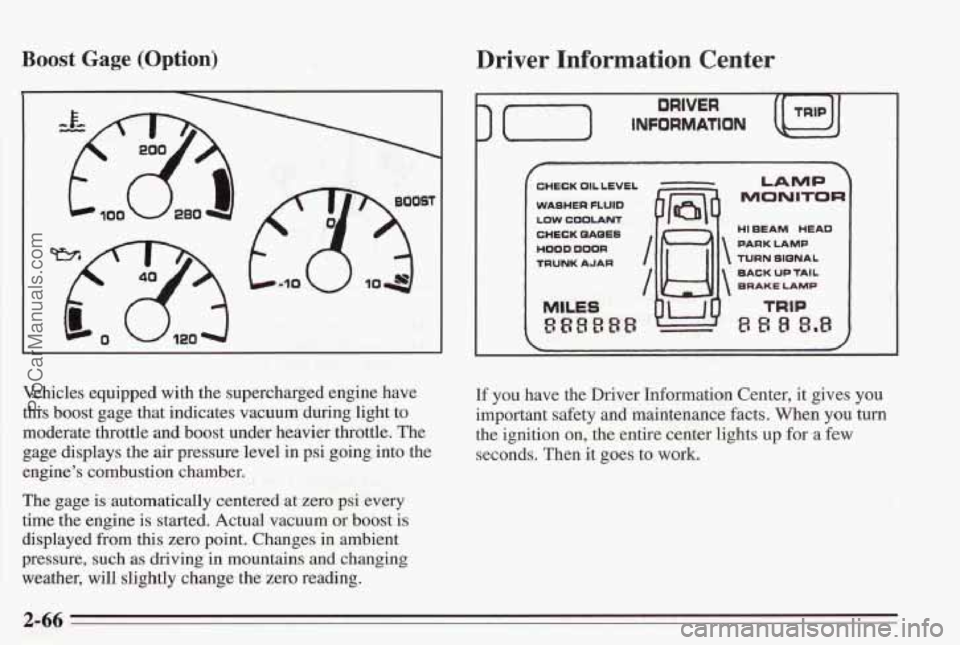
Boost Gage (Option)
Vehicles equipped with the supercharged engine have
this boost gage that indicates vacuum during light to
moderate throttle and boost under heavier throttle. The
gage displays the air pressure level in psi going into the
engine’s combustion chamber.
The gage is automatically centered at zero psi every
time the engine is started. Actual vacuum or
boost is
displayed from this zero point. Changes in ambient
pressure, such
as driving in mountains and changing
weather, will slightly change the zero reading.
Driver Information Center
) (-) INFORMATION
DRIVER
CHECK OIL LEVEL
WASHER
FLUID
LOW COOLANT
CHECK QAQES
HOOD DOOR
TRUNK AJAR
MILES
888888
I /w
7
LAMP
MONITOR
HI EEAM HEAD
PARK LAMP
TURN SIQNAL
BACK
UP TAIL
BRAKE LAMP
If you have the Driver Information Center, it gives you
important safety and maintenance facts. When you turn
the ignition on, the entire center lights
up for a few
seconds. Then it goes to work.
2-66
ProCarManuals.com
Page 116 of 338
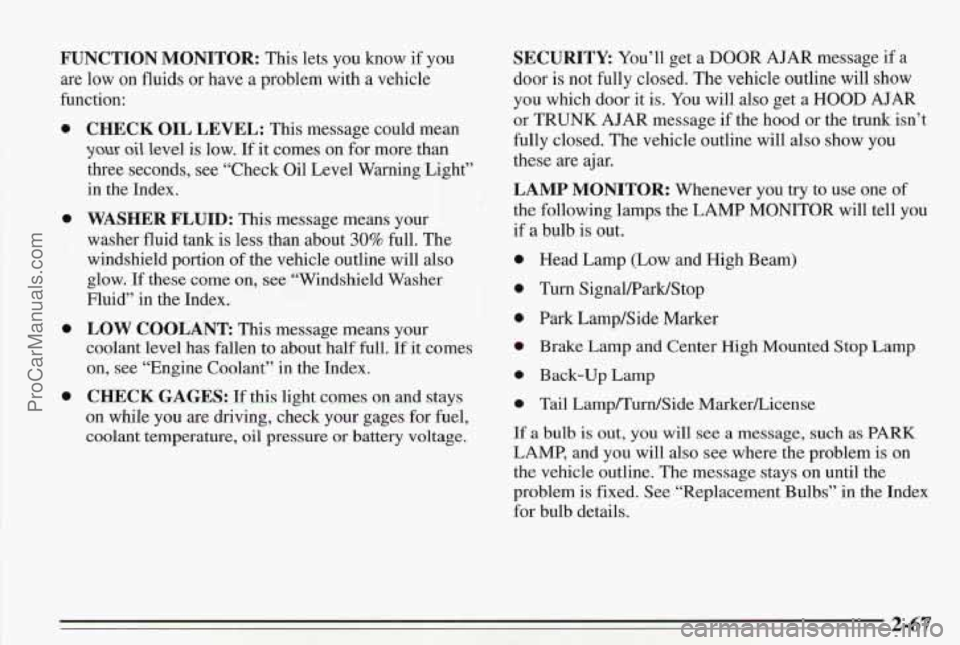
FUNCTION MONITOR: This lets you know if you
are low on fluids or have a problem with a vehicle
function:
0
0
0
0
CHECK OIL LEVEL: This message could mean
you oil level is low. If it comes on for more than
three seconds, see “Check Oil Level Warning Light”
in the Index.
WASHER FLUID: This message means your
washer fluid tank is less than about
30% full. The
windshield portion of the vehicle outline will also
glow.
If these come on, see “Windshield Washer
Fluid” in the Index.
LOW COOLANT This message means your
coolant level has fallen
to about half full. If it comes
on, see “Engine Coolant”
in the Index.
CHECK GAGES: If this light comes on and stays
on while you are driving, check your gages for fuel,
coolant temperature,
oil pressure or battery voltage.
SECURITY: You’ll get a DOOR AJAR message if a
door
is not fully closed. The vehicle outline will show
you which door it is.
You will also get a HOOD AJAR
or TRUNK AJAR message if the hood or the trunk isn’t
fully closed. The vehicle outline will also show you
these are ajar.
LAMP MONITOR: Whenever you try to use one of
the following lamps the LAMP MONITOR will tell you
if
a bulb is out.
Head Lamp (Low and High Beam)
Turn SignaWarWStop
Park Lamp/Side Marker
Brake Lamp and Center
High Mounted Stop Lamp
Back-up Lamp
Tail Lamp/Turn/Side MarkerLicense
If
a bulb is out, you will see a message, such as PARK
LAMP, and you will also see where the problem is on
the vehicle outline. The message stays on until the
problem is fixed. See “Replacement Bulbs” in the Index
for bulb details.
2-67
ProCarManuals.com
Page 166 of 338

If you drive regularly in steep country, or if you’re
planning to visit there, here are some tips that can make
your trips safer and more enjoyable.
Keep your vehicle in good shape. Check all fluid
levels and also the brakes, tires, cooling system and
transaxle. These parts can work hard on mountain
roads.
Know how to go down hills. The most important
thing to know is this: let your engine
do some of the
slowing down. Shift to
a lower gear when you go
down a steep or long hill.
a
a
0
a
Know how to go uphill. Shift down to DRIVE (D).
This will help cool your engine and transaxle, and
you can climb the hill better.
Stay in your own lane when driving
on two-lane
roads
in hills or mountains. Don’t swing wide or cut
across the center of the road. Drive at speeds that let
you stay in your
own lane.
As you go over the top of a hill, be alert. There could
be something in your lane, like a stalled car or an
accident.
You may see highway signs on mountains that
warn
of special problems. Examples are long grades,
passing or no-passing
zones, a faIIing rocks area, or
winding
roads. Be alert to these and take appropriate
action.
4-23
ProCarManuals.com
Page 179 of 338

Parking on Hills
You really should not park your vehicle, with a trailer
attached, on
a hill. If something goes wrong, your rig
could start to move. People can be injured, and both
your vehicle and the trailer can be damaged.
But
if you ever have to park your rig on a hill, here’s
how to do it:
1. Apply your regular brakes, but don’t shift into
PARK (P) yet.
2. Have someone place chocks under the trailer wheels.
3. When the wheel chocks are in place, release the
regular brakes until the chocks absorb the load.
4. Reapply the regular brakes. Then apply your parking
brake, and then shift to
PARK (P).
5. Release the regular brakes.
When You Are Ready to Leave After
Parking
on a Hill
1. Apply your regular brakes and hold the pedal down
while you:
Start your engine;
Shift into a gear; and
Release the parking brake.
2. Let up on the brake pedal.
3. Drive slowly until the trailer is clear of the chocks.
4. Stop and have someone pick up and store the chocks.
Maintenance When Trailer Towing
Your vehicle will need service more often when you’re
pulling a trailer. See the Maintenance Schedule for more
on this. Things that are especially important in trailer
operation are automatic transaxle fluid (don’t overfill),
engine
oil, belts, cooling system, and brake adjustment.
Each
of these is covered in this manual, and the Index will
help you find them quickly. If you’re trailering, it’s a good
idea
to review these sections before you start your trip.
Check periodically to see that all hitch nuts and bolts
are tight.
4-36
ProCarManuals.com
Page 233 of 338
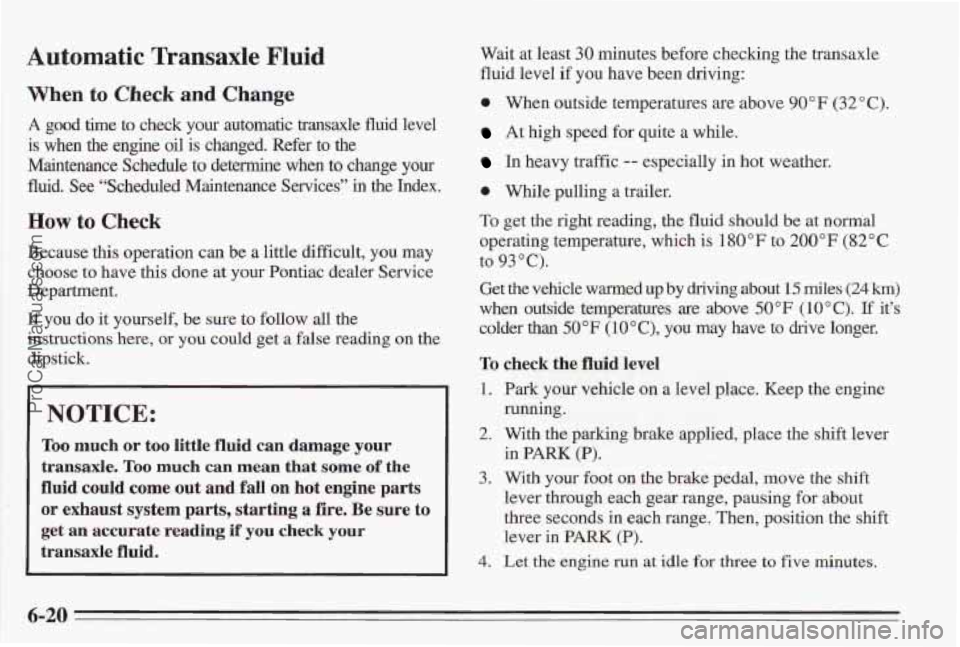
Automatic Transaxle Fluid
When to Check and Change
A good time to check your automatic transaxle fluid level
is when the engine oil is changed. Refer to the
Maintenance Schedule to detemrrine when to change your
fluid. See "Scheduled Maintenance Services" in the Index.
How to Check
Because this operation can be a little difficult, you may
choose
to have this done at your Pontiac dealer Service
Department.
If you do it yourself, be sure to follow all the
instructions here, or you could get a false reading on the
dipstick.
NOTICE:
Too much or too little fluid can damage your
transaxle.
Too much can mean that some of the
fluid could come out and fall
on hot engine parts
or exhaust system parts, starting a fire. Be sure to
get an accurate reading if you check your
transaxle fluid.
~~~
Wait at least 30 minutes before checking the transaxle
fluid level
if you have been driving:
0 When outside temperatures are above 90" F (32°C).
At high speed for quite a while.
In heavy traffic - especially in hot weather.
0 While pulling a trailer.
To get the right reading, the fluid should be at normal
operating temperature, which is
180 "F to 200°F (82" C
to 93 "C).
Get the vehicle warmed up by driving about €5 des (24 km)
when outside temperatures are above 50°F (10°C). If it's
colder
than 50°F (lO"C), you may have to drive longer.
To check the fluid level
1. Park your vehicle on a level place. Keep the engine
running.
2. With the parking brake applied, place the shift lever
in PARK (P).
3. With your foot on the brake pedal, move the shift
lever through each gear range, pausing for about
three seconds
in each range. Then, position the shift
lever in PARK (P).
4. Let the engine run at idle for three to five minutes.
6-20
ProCarManuals.com
Page 240 of 338

Brakes
Brake Master Cylinder
Your brake master cylinder is here. It is filled with
DOT-3 brake fluid. fluid is leaking
out
of the brake system. If it is, you
should have your brake system fixed, since
a leak means
that sooner or later your brakes won’t work well,
or
won’t work at all. So, it isn’t a good idea to “top off’
your brake fluid. Adding brake fluid won’t correct a
leak. If you add fluid when your linings are worn, then
you’ll have too much fluid when you get new brake
linings. You should add (or remove) brake fluid, as
necessary, only when work is done on the brake
hydraulic system.
There are only two reasons why the brake fluid level in
your master cylinder might go down. The first is that the
brake fluid goes down to an acceptable level during
noma1 brake lining wear. When new linings are put in,
the fluid level goes back up. The other reason is that When your brake fluid falls to a
low level, your brake
warning light will come on.
A chime will sound if you
try to drive with this warning light on. See ‘‘B*
System Warning Light” in the Index.
6-27
ProCarManuals.com
Page 241 of 338
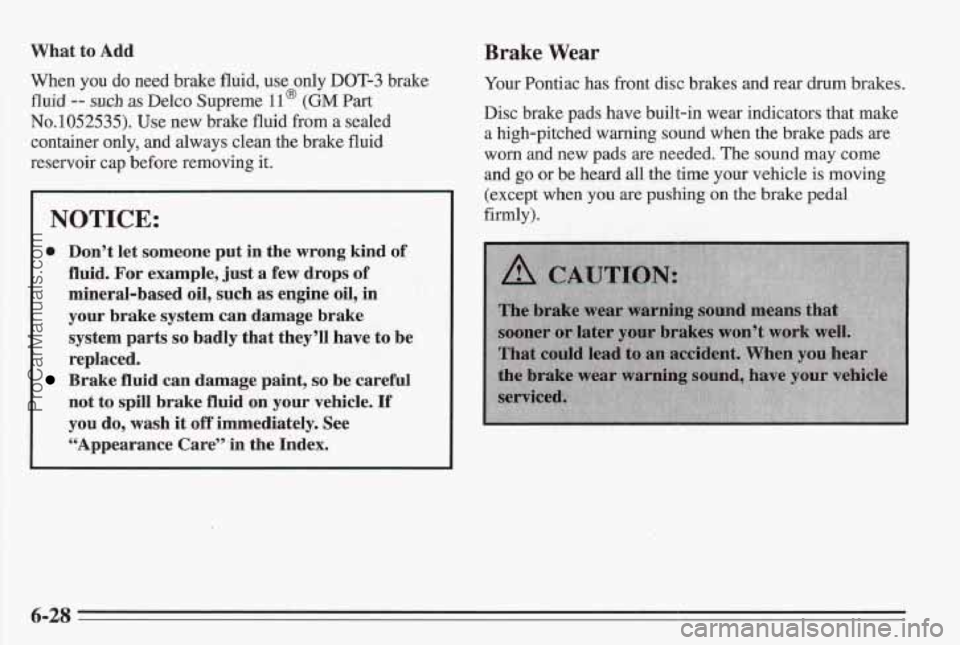
What to Add
When you do need brake fluid, use only DOT-3 brake
fluid
-- such as Delco Supreme 11 @ (GM Part
No.1052535). Use new brake fluid from a sealed
container only, and always clean
the brake fluid
reservoir cap before removing it.
I NOTICE:
~ 0 Don’t let someone put in the wrong kind of
’ fluid. For example, just a few drops of
mineral-based oil, such as engine oil, in
your brake system can damage brake
system parts
so badly that they’ll have to be
replaced.
Brake fluid can damage paint, so be careful
not to spill brake fluid on your vehicle.
If
you do, wash it off immediately. See
“Appearance Care” in the Index.
Brake Wear
Your Pontiac has front disc brakes and rear drum brakes.
Disc brake pads have built-in wear indicators that make
a high-pitched warning sound when the brake pads are
worn and new pads are needed.
The sound may come
and
go or be heard all the time your vehicle is moving
(except when you are pushing
on the brake pedal
firmly).
6-28
ProCarManuals.com
Page 280 of 338
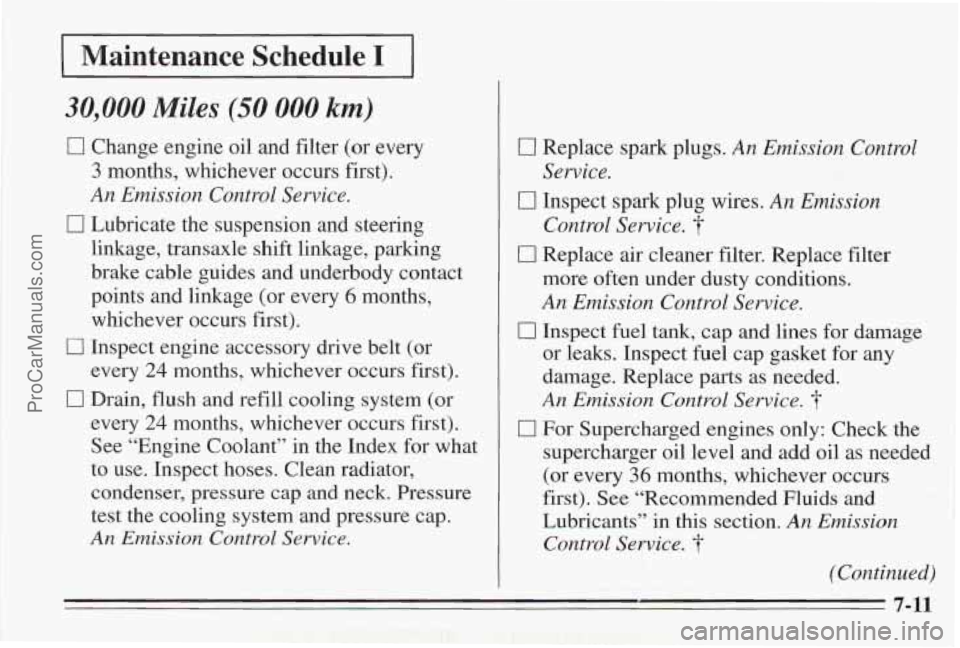
Maintenance Schedule I
30,000 Miles (50 000 km)
0 Change engine oil and filter (or every
3 months, whichever occurs first).
An Emission Control Service.
0 Lubricate the suspension and steering
linkage, transaxle shift linkage, parking
brake cable guides and underbody contact
points and linkage (or every
6 months.
whichever occurs first).
0 Inspect engine accessory drive belt (or
every 24 months, whichever occurs first).
0 Drain, flush and refill cooling system (or
every
24 months, whichever occurs first).
See “Engine Coolant’’ in the Index for what
to use. Inspect hoses. Clean radiator,
condenser, pressure cap and neck. Pressure
test the cooling system and pressure cap.
An Emission Control Service.
0 Replace spark plugs. An Emission Control
0 Inspect spark plug wires. An Emission
0 Replace air cleaner filter. Replace filter
Service.
Control Service.
-f
more often under dusty conditions.
An Emission Control Service.
0 Inspect fuel tank, cap and lines for damage
or leaks. Inspect fuel cap gasket for any
damage. Replace parts as needed.
An Emission Control Service. 4
[7 For Supercharged engines only: Check the
supercharger oil level and add oil as needed
(or every
36 months, whichever occurs
first). See “Recommended Fluids and
Lubricants” in this section.
An Emission
Control Service.
(Continued)
7-11
ProCarManuals.com
Page 284 of 338
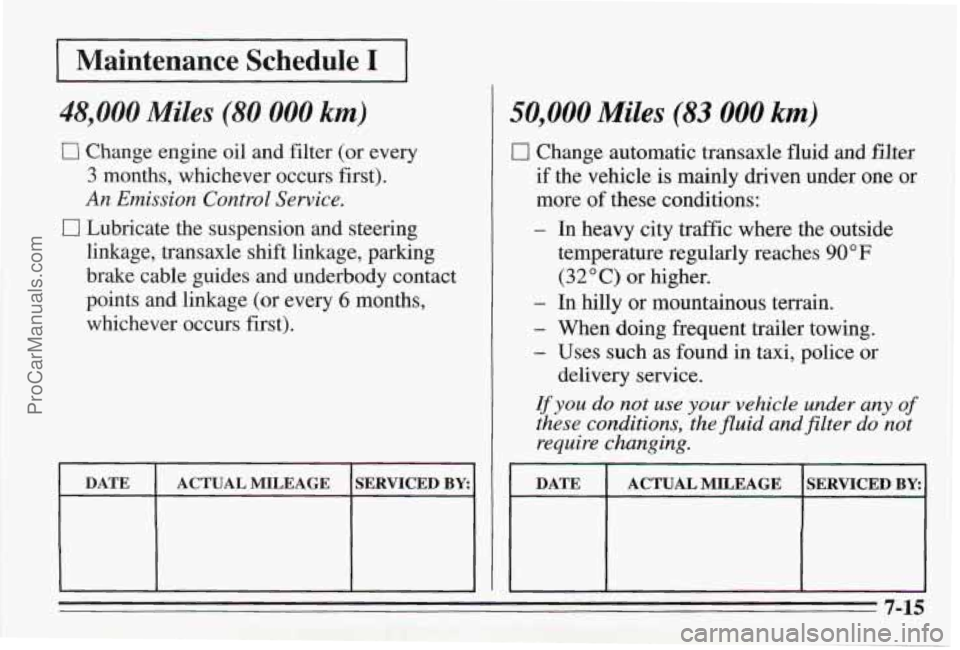
1 Maintenance Schedule I I
48,000 Miles (80 000 km)
0 Change engine oil and filter (or every
3 months, whichever occurs first).
An Emission Control Service.
0 Lubricate the suspension and steering
linkage, transaxle shift linkage, parking
brake cable guides and underbody contact
points
and linkage (or every 6 months,
whichever occurs first).
DATE
SERVICED BY ACTUAL MILEAGE
50,000 Miles (83 000 km)
0 Change automatic transaxle fluid and filter
if the vehicle is mainly driven under one or
more
of these conditions:
- In heavy city traffic where the outside
temperature regularly reaches
90 OF
(32°C) or higher.
- In hilly or mountainous terrain.
- When doing frequent trailer towing.
- Uses such as found in taxi, police or
delivery service.
If you do not use your vehicle under any of
these conditions, the fluid and filter do not
require changing.
I DATE I ACTUAL MILEAGE ISERVICED BXI
7-15
ProCarManuals.com
Page 298 of 338
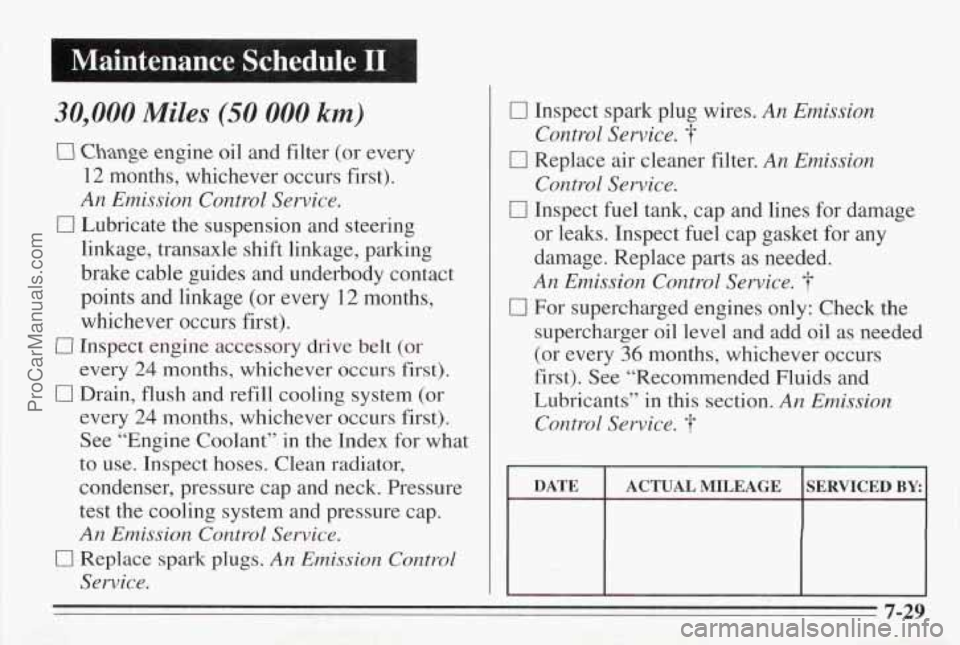
flaintenance Schedule I1 I
30,000 Miles (50 000 km)
El Change engine oil and filter (or every
12 months, whichever occurs first).
An Emission Control Service.
0 Lubricate the suspension and steering
linkage, transaxle shift linkage, parking
brake cable guides and underbody contact
points and linkage (or every
12 months,
whichever occurs first).
CI Inspect engine accessory drive belt (or
every 24 months, whichever occurs first).
0 Drain, flush and refill cooling system (or
every
24 months, whichever occurs first).
See “Engine Coolant” in the Index for what
to use. Inspect hoses. Clean radiator,
condenser, pressure cap and neck. Pressure
test the cooling system and pressure cap.
An Emission Control Service.
0 Replace spark plugs. An Emission Control
Service.
0 Inspect spark plug wires. An Emission
Control Service.
0 Replace air cleaner filter. An Emission
Control Service.
0 Inspect fuel tank, cap and lines for damage
or leaks. Inspect fuel cap gasket for any
damage. Replace
parts as needed.
An Emission Control Service. 3-
0 For supercharged engines only: Check the
supercharger oil level and add oil as needed
(or every
36 months, whichever occurs
first). See “Recommended Fluids and
Lubricants” in this section.
An Emission
Control Service.
7-29
ProCarManuals.com